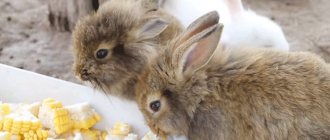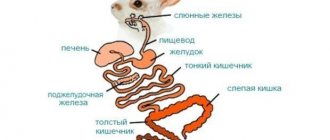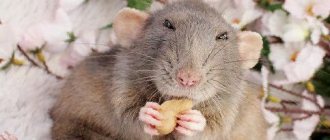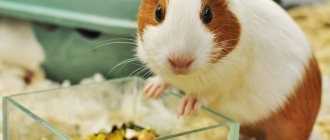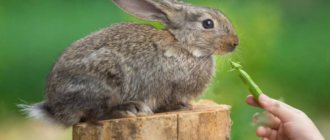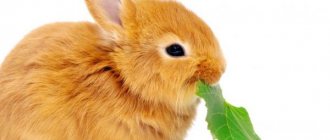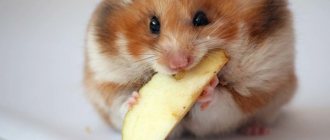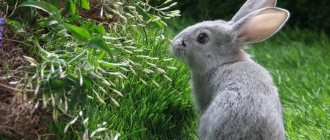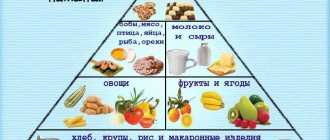Experienced rabbit breeders recommend giving animals branches instead of the usual winter roughage at the beginning of spring. This food is not only nutritious and easily accessible, but also practically inexpensive. This article will help you figure out how to properly feed rabbits with branches, which of them are beneficial and which are harmful, and how to properly prepare branch food.
The importance of roughage for rabbits
The structural features of the gastrointestinal tract of rabbits create certain problems with their feeding, forcing rabbit breeders to select only the most suitable feed for these purposes. Practically omnivorous animals should not be overfed with carbohydrates and fats, but fiber-rich roughage should be added. They allow pets to grind down their ever-growing teeth.
Branches of woody plants saturate the rabbit's body with nutrients, being an inexhaustible source of beneficial vitamins and microelements. They compensate for the lack of basic feed in winter and reduce the risk of cell damage.
To wear down their teeth, rabbits constantly gnaw on the wooden floor and bars of the cage, and if there are branches in it, they happily switch to them.
Plant shoots can be prepared in advance. It is better to harvest tree branches in the fall, when their nutrient content is maximum. You can give branches to rabbits until green food appears in the spring.
Along with traditional alder, apple, birch and willow shoots, you can feed rabbits with branches of maple, poplar, ash and pine needles. True, certain rules must be followed.
Medicinal branch food
Often branches for rabbits serve as a therapeutic agent. They are useful for digestion, since in addition to succulent grass, the diet should also contain roughage. Otherwise, pets will suffer from bloating and diarrhea.
Adding branches to your diet will help you avoid vitamin deficiency, as they contain nutrients, fiber, and are rich in vitamins and microelements. Each plant acts differently:
- Alder and oak are especially good for digestive problems.
- Aspen and willow are trees with antimicrobial properties.
- Linden and willow have anti-inflammatory properties and also relieve pain.
- Birch regulates the functioning of the kidneys and urinary system.
- Cystitis - linden and birch .
- Coniferous trees are rich in vitamin C; consuming them in winter will reduce the risk of colds. And the presence of essential oils in the composition will help with respiratory diseases.
Branch food is indispensable for grinding down the teeth of any rodents, which is necessary for proper bite. If teeth are not ground down, they will begin to grow quickly, bulge, bend, and grow into soft tissue. This leads to the fact that the pet cannot eat normally, loses weight, and even develops anorexia and other diseases. The presence of branches in the animal's cage will prevent this. In addition, a rabbit grinding down its teeth will not damage the cage and other objects around it.
What branches can you give to rabbits?
The main food for decorative rabbits is hay and granulated food, and in summer also grass. But as a supplement to the diet, you can give rabbits branches of the following trees almost every day:
- Apple tree
- Poplar
- Mulberry
- Acacia
- Maple
- Ash
- Raspberries
- Grape
- Hazel
- Currant
- Aspen
- Linden
Can rabbits eat pine branches? Yes, like other conifers, but they should not be given too often. From time to time, decorative and ordinary eared animals can also be given tree branches:
- Oak
- Birch
- Willow
- Juniper
- Alder
- Pear
- Chestnut
- Rowan
- Walnut
Branches from apple trees, hazels, and grapes can be given along with the fruits, and currants without berries. Rowan and chestnut are also without fruit, and only sometimes and in small portions. Walnut branches are given a little at a time to prevent parasites.
Birch branches have a diuretic property, willow and linden have an analgesic effect, oak and alder help with diarrhea, and coniferous branches are rich in vitamin C. Considering the listed properties, these branches are given only occasionally for prevention.
Tree branches contain vitamins, microelements, fiber and various substances that are not found in all herbs and grains. Therefore, in the correct diet for a rabbit, branches are an essential component.
What kind of bark can be given to rabbits?
Rabbits are also great at eating aspen bark collected from trees 1-2 months after cutting. Branch food is fed in winter and summer along with hay. Rabbits can also have nettles. If there is a shortage of hay, it can be replaced with twig feed.
There is a whole line of dry twig and wood food for decorative rabbits.
Rabbits are usually given pine, spruce and juniper needles. Needles are fed from October to March, depending on the weather. The earlier the cold comes, and the later spring comes, the longer this type of feed is used. In the spring, the content of resinous and tannin substances and essential oils in the needles increases. Which is not good for rabbits. In winter, pine needles are the main source of carotene, vitamins C, E and group B.
There is an opinion that it is forbidden to give branches of stone fruit trees to rabbits. Due to the presence of hydrocyanic acid in them. This belief is wrong. There is no strong acid in the branches and leaves of stone fruit trees. It is present only in the bones themselves, or rather not even an acid, but a substance, when destroyed, hydrocyanic acid is released in the body. Therefore, you should not feed the bones themselves to the rabbit. And branches and leaves of stone fruit trees, such as:
- apricot,
- plum,
- cherry,
- cherries,
- cherry plum and other trees can be given to rabbits without fear.
The benefits of branches in a rabbit's diet
Branch food has long proven its usefulness in the menu of rabbits of various breeds. It has a beneficial effect on the body of animals and is an excellent food substitute when there is a lack of hay. Rabbits love to eat fresh branches of trees and bushes - this confirms the instinctive behavior of wild representatives of this order of animals.
Rabbit breeders note the main advantages of this type of feeding:
- Significantly increases the digestibility of other feeds.
- Prevents digestive disorders, especially in the summer, when the diet of animals is literally oversaturated with green plants, which often provokes diarrhea.
- Serves as a reliable prevention of various diseases. Branch food contains not only a large amount of fiber, but also proteins, vitamins, and microelements.
- Helps treat various body disorders. Branches are a kind of natural healers (for example, a willow branch contains the glycoside salicin, which can be called a natural antibiotic). Wild animals unmistakably determine which plant to use for treatment, while domestic animals have retained the abilities of their ancestors.
- The mood and mobility of animals improves.
One of the important advantages of twig feed is its availability. If necessary, you can cut it nearby, right near your home. If you have your own garden, you can serve fresh branches to your rabbits for lunch almost all year round, even in winter. Although it is better to take care of preparing them in advance, in the spring and summer, when they are most saturated with vitamins.
The nutritional value of food from branches is quite high and largely depends on the number of leaves. At this position, the branch feed is located between the straw and hay.
Pine needles rich in protein and vitamins
The branches of spruce, pine and fir, widespread in central Russia, are a real storehouse of vitamins and minerals. They contain at least 10% of protein, which is perfectly digestible by the body of rabbits, and are also rich in minerals that strengthen the body.
03:00
Is it possible to give rabbits coniferous branches: pine, spruce.
Let's look at whether it is possible to give a rabbit pine branches, how to do it correctly, in what quantity and at what time of year.
The shoots of coniferous plants are saturated with a large amount of essential oils, which give them a unique rich smell. They can cause irreparable harm to the health of your pets, so pine needles for rabbits are useful only in winter, when the concentration of these substances sharply decreases.
If you are going to feed rabbits with fir, pine or Christmas tree branches, then under no circumstances prepare them in the spring and summer months. Such preparation will be useless, rabbits will lose their appetite, and their health may seriously deteriorate.
When are pine needles dangerous?
Its harm is expressed in essential oil, which is abundant in summer spruce, pine, and cedar branches. Therefore, in spring and summer, roughage should consist of twigs of deciduous trees or garden trees, except plum, peach, and apricot.
Features of harvesting coniferous branches
There are no particular differences in which coniferous branches to choose for a rabbit. For these purposes, spruce and pine, which can be found in any Russian forest, are best suited.
Rules for choosing needles for rabbits:
- We carry out harvesting after the onset of the first frost;
- we find a large Christmas tree or pine tree growing far from busy highways;
- select branches older than two years;
- the needles should be bright and faintly scented.
It is best to cut enough needles so that the rabbits have enough for 2-3 days, after which the procedure is repeated. You can bring home more branches, but as they dry out they will lose their beneficial substances. First of all, vitamin C is very useful.
08:00
Instructions for harvesting and using needles for rabbits
An adult animal is given one branch (15-20 cm) per day, regardless of whether it is spruce or another coniferous plant. Before putting the fertilizer into the cage, be sure to rinse it with clean water and let it dry a little.
Dousing the spruce with boiling water is strictly prohibited, as this will provoke the release of essential oils contained in it, which can negatively affect the pet’s body.
What can you feed besides branches?
Of course, it would be inappropriate to formulate a diet based on twig food alone. Nutrition is divided into feeding green, succulent and roughage.
Rabbits love grass, and it is necessary for the normal functioning of their bodies. Therefore, simultaneously with collecting branches, you can begin the process of harvesting grass. It should be remembered that plants collected in the late growth period are deprived of the amount of valuable elements that they possess during the period of formation and maturation. In addition, in the early stages they do not contain large amounts of fiber, which is poorly digested by rabbits.
Animals should not be given only one type of grass.
Animals are more willing to eat green food, which is characterized by variety. It is not recommended to give freshly cut grass to rabbits, especially if it was collected early in the morning, retaining drops of dew, or after it has rained. To increase its digestibility, it should be dried a little.
Experienced farmers have noticed that if it is necessary to speed up the weight gain of rabbits or improve the quality of the undercoat, you can diversify the diet with baked goods.
You can only give your rabbits bread, not pastries.
There are many varieties of food that are beneficial for the bodies of furry pets, among which twig food should be given special attention
Branch food must be present in the rabbit nutrition system
Branch food is an excellent resource for preparing a high-quality, properly balanced diet for eared animals. Economic and practical benefits make it attractive for use in both small rural farms and large livestock farms. In addition, it significantly reduces the cost of keeping furry pets.
Video - Feeding rabbits with tree branches
Raspberry belongs to the subshrub, is often found in Russia and occupies a leading position among plants found in garden plots.
Which tree branches are not allowed for rabbits?
And so, now you know what branches you can give to rabbits. The next step is to find out which tree branches cannot be fed to domestic rabbits.
- Bird cherry
- Elder
- Wolf's Bast
- Ledum
- Lilac
- Oleander (ornamental shrub)
These trees contain poisonous and toxic substances, which means their branches are dangerous to the health of decorative and ordinary rabbits.
However, it is better not to give branches of the following trees to long-eared animals too often:
- Cherry
- Apricot
- Cherries
- Cherry plum
- Plum
Although, on the forums, many rabbit breeders note that they feed their animals with branches of cherries, cherry plums, and cherries. However, no negative consequences are observed.
That's all, now you know which branches can be given to rabbits and which ones cannot be given. By the way, if you have experience in this matter, be sure to write about it in the comments below (for example, which tree branches does your pet like the most).
Is it possible to give horseradish leaves to rabbits?
It is not recommended to give any green food to rabbits in its pure form, including horseradish leaves. ... Horseradish leaves can be given to rabbits in winter - just dry them properly.
Interesting materials:
How to boot from a flash drive in Asus? How to make kombucha at home? How to dry clean a jacket at home? How to square a number in Excel? How to make a currency format in Excel? How to make a discount in Excel? How to make Excel read-only? How to multiply by the same cell in Excel? How to do subtraction in Excel? How to make only one color brighter in Photoshop?
Rules for selecting and preparing branches for food
You need to choose wood for rabbits responsibly. Decorative rabbits can suffer from low-quality wood.
You may worry less about species with thin branches that are less likely to crumble. We are talking about branches of viburnum and grapes.
In summer and spring, branches should be harvested shortly before giving them to the rabbits. Even branches with foliage are suitable for summer harvesting. During this period, the leaves contain the maximum amount of compounds beneficial to the rodent’s body. At the end of summer, you can prepare brooms, which are intended for feeding animals in the autumn and winter.
Therefore, branches of spruce, pine, and juniper are issued immediately after collection. But from February to May you should not collect pine needles. During this period, harmful substances, collectively called bitter resin, are concentrated in it.
Regardless of the choice of tree species and time of collection, you need to think about where to get the branches. The ideal option is if you can collect them on your site. This way you can ensure that the tree is not damaged due to chemicals. This significantly increases the risk of poisoning in pets.
How to feed correctly
Despite all the benefits of such food, you should not feed one tree all the time. The best effect will be shown by alternating different varieties with each other. There are some recommendations for feeding rabbits with twig food:
- Summer pruning is given fresh.
- Autumn twigs are not suitable for fresh consumption; it is better to dry them for the winter.
- If the leaves are edible, feed them first.
- Needles are given only fresh.
- Before giving pine to rabbits, check to see if there is any resin on it.
- You should not feed only this food; it serves to dilute and supplement the main diet.
Useful tips
When you have found out what trees rabbits eat and what branches they provide in winter and summer, you need to understand the nuances of feeding rabbits with wood.
Some tips from experienced rabbit breeders can help you avoid making stupid mistakes and reduce the likelihood of negative consequences from eating twigs:
- Wash branches and brooms before giving them to rabbits. It is better to do this in hot water. This way you will perform two tasks at once: soften the wood and remove serious contamination from the surface of the branch;
- Use branches especially often in early autumn and spring. This will help prevent diseases; wood is a natural antibiotic. This is especially true for raspberry branches with leaves;
- When choosing branches to harvest for the winter, cut off those that have many leaves. The number of leaves is a direct sign that the branch contains a lot of tree sap;
- Avoid dry and rotting branches. And under no circumstances put branches that are covered with fungus into the enclosure. It can easily spread to the bedding, then you will have to disinfect the cage;
- Remember that animals do not eat large branches. They simply gnaw the bark off them. Therefore, it is better to choose thin rods for rabbits. Another disadvantage of large branches is that they are difficult to remove from their cages for replacement;
- Keep in mind that some branches have a diuretic effect. This means that after using them in rabbit cages you will have to clean more often. In order not to be disappointed in such food, be sure to read about the characteristics of plants;
- To better preserve the branches, cut them with a special garden pruner. A miniature hatchet will also work if we are talking about a plant with strong bark and wood.
If you don’t want to prepare plants yourself, but understand their value for your charges, you can buy wooden blocks for rodents. They are sold at any zoological store. But, if you have the opportunity to collect wood yourself, you should use it.
Beneficial properties and correct dosage of some plants when feeding
On the one hand, summer is a wonderful time. There are no problems with feeding, and a wide selection of different plants gives many options for providing an optimal diet for fluffy ones. But this is only at first glance. The risks of various diseases increase: from diarrhea to worms. In this regard, it is necessary to highlight the following point: what tree branches can be given to rabbits in the summer? In this case, it all depends on the situation. Below is a small list of plants recommended for use for treatment and prevention in dosed quantities.
This includes branches of rowan, chestnut, and mulberry. Be careful when using birch, which has a tremendous diuretic effect. It is used infrequently, in small proportions, to cure kidney disease. If these rules are not followed, there is a high probability that the rabbits may die from dehydration. Too much feed can lead to indigestion. Branches of oak, alder and maple act as a preventive measure. After consumption for several days, it is recommended to mix them with other breeds. Walnut – destroys parasites. Coniferous branches are also useful on the farm. The needles themselves are an excellent antiseptic and, moreover, they are rich in phytoncides and essential oils.
The benefits of branch feeding
In addition to the health benefits that branch feed provides to animals and its availability at any time of the year, it is also attractive from an economic point of view. Its benefits lie in the following factors:
- Low cost. Using this feeding method, the owner incurs virtually no costs, with the exception of physical labor when collecting and drying branches.
- Interchangeability with other feeds. If there is a lack of winter supplies, especially in early spring, dried branches are an excellent substitute for hay or straw.
Separately, we should dwell on the issue of safety of cells and other equipment. Every rabbit owner has seen chewed wooden elements of rabbit hutches. This happens for some reason. The fact is that rabbits' teeth never stop growing and add 1 millimeter every 3 days. Rabbits must constantly grind them down so that their bite is not disturbed. To do this, they use rough food, and in the absence of such food, there will be no mercy on the walls, floor, drinking bowls and other objects. This is significant damage to the farm, which can be prevented by simply including branches in the rabbits’ diet.
You will find more information about why rabbits chew wooden cages and how to wean them from this activity here.
Feeding ornamental animals
With great pleasure, decorative and dwarf rabbits eat the needles of coniferous plants, preferring the Christmas tree to all other trees. You can start putting one sprig of pine needles in a baby’s cage as early as two months of age. But in the first days you need to carefully monitor the health of your pets.
In decorative rabbits that are not accustomed to such food, the urine may acquire a reddish tint in the first days. But this should not bother you, because it is absolutely normal.
Fattening animals happily gnaw on the branches themselves, leaving practically nothing left of them. Often, the remains of a New Year's tree that has stood in your home for 2 or more weeks are added to their diet. They are not as healthy as fresh ones, but rabbits will eat them just as well.
If pine or spruce were grown in warm regions of the country before the onset of frost, then its branches cannot be fed to rabbits. Freezing already cut branches in the refrigerator will not give a positive effect either.
Inexpensive and highly effective fertilizer
Spruce, pine, fir and juniper stop producing essential oils with the onset of the first cold weather. Only after this can their branches be cut off and added to rabbit food.
It is not recommended to prepare pine branches in advance. When they dry out, they lose some of their beneficial substances, and they can be cut from the tree at any time.
It is believed that giving pine needles is very useful, since it improves the functioning of the digestive system of decorative rabbits, which are much weaker than their counterparts raised industrially to produce high-quality meat and fur.
Feeding animals with coniferous branches rich in vitamin C stimulates sexual estrus. Giving them to nursing rabbits will increase their milk production. Read more about this in the article “What to feed a female rabbit after giving birth.”
Young rabbits eat pine needles with great pleasure, regardless of whether you give them spruce, fir or pine. Adding spruce branches to the diet makes their fur bright and shiny, eliminating vitamin deficiencies that are accompanied by hair loss.
